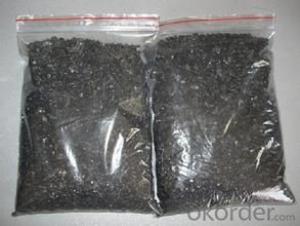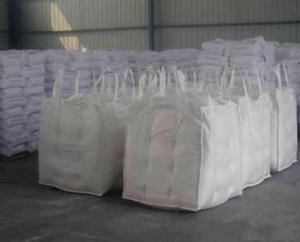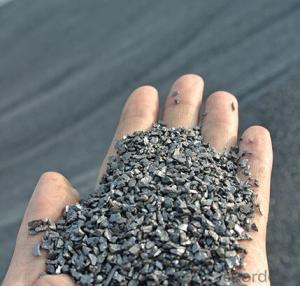Recarburizer 1-3MM 93% FC Carburant Carbon Additives
- Loading Port:
- Qingdao
- Payment Terms:
- TT OR LC
- Min Order Qty:
- 10 m.t.
- Supply Capability:
- 50000 m.t./month
OKorder Service Pledge
OKorder Financial Service
You Might Also Like
Specifications Of Recarburizer 93% FC
- High C content;
- Low S and N content;
- High abosorbility;
Recarburizer(Carburant, carbon additives) with high quality, 0-20mm for metal casting foundry and steel plant, low nitrogen content and high carbon content, min 90% carbon content, at the same time as your requirements with no problem. The best media for adding carbon.
Technical Data Sheet of Recarburizer 93% FC
Fixed carbon | ≥ 93% |
Ash content | ≤ 5.0% |
Vol . Matter | ≤ 1.0% |
Sulphur content | ≤ 0.3% |
Moisture content | ≤ 0.3% |
Size | 0-20mm or as your requirement. |
Packing | - 25kg bag - One tone bags, Jumbo bag |
Delivery time | In 5-10 working days or depends on the order quantity |
Supply ability | 50000 Metric Ton Per Month |
Payment terms | L/C at sight or T/T |
Available Size: 0,1-4mm, 1-5mm, 3-8mm, 8-20mm (as per customers’ requirements)
Usage: widely used in casting foundry, steel-making, metallurgical Etc.
Applications of Recarburizer 93% FC
Mainly used in steel making in electrical stove, screening water, ship building sandblast to remove rust,producing carbon materials Etc.
Characteristics of Recarburizer 93% FC
- Particle size, porosity, absorption speed stable
- High degree of carbonize product, increase the original nuclear capability in the shape of liquid iron.
- Increased in the inoclation of nodular cast iron ball ink quantiyt, increase in th electric furnace iron graphit crystal nucleus.
- Excellent performance, stable.
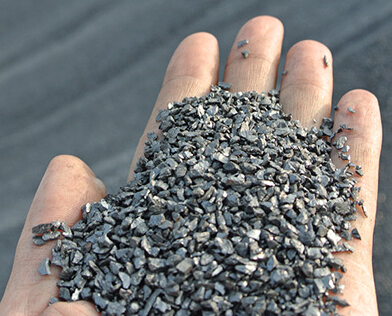

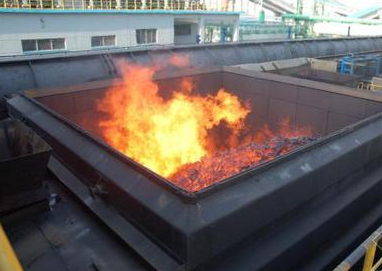

- Q:How does carbon dioxide affect waste management processes?
- Carbon dioxide (CO2) has a significant impact on waste management processes. One of the main ways in which it affects waste management is through the decomposition of organic waste. When organic waste, such as food scraps or yard waste, is sent to landfills, it undergoes anaerobic decomposition due to the lack of oxygen. This process produces methane (CH4), a potent greenhouse gas that contributes to climate change. Methane is approximately 25 times more effective at trapping heat in the atmosphere than carbon dioxide over a 100-year period. Therefore, the presence of carbon dioxide in waste management processes indirectly results in increased methane emissions, exacerbating the greenhouse effect. Moreover, carbon dioxide emissions from waste management activities can occur during the transportation and disposal of waste. The collection and transportation of waste to landfills or incineration facilities require the use of vehicles that typically run on fossil fuels, releasing carbon dioxide into the atmosphere. Additionally, waste incineration generates carbon dioxide emissions, as the combustion process produces CO2 as a byproduct. To mitigate the impact of carbon dioxide on waste management, several strategies can be employed. Firstly, reducing the amount of waste generated through waste reduction and recycling efforts can help minimize the need for landfilling or incineration, thereby reducing carbon dioxide emissions associated with waste management. Furthermore, implementing waste-to-energy technologies, such as anaerobic digestion or landfill gas capture, can help to harness the energy potential of organic waste, while simultaneously reducing methane emissions. Anaerobic digestion converts organic waste into biogas, which can be used to generate electricity or heat, while landfill gas capture systems collect methane emitted from landfills and use it for energy production. Lastly, transitioning to low-carbon transportation options, such as electric or hybrid vehicles, for waste collection and transportation can help reduce carbon dioxide emissions associated with waste management processes. In conclusion, carbon dioxide affects waste management processes by contributing to the production of methane during the decomposition of organic waste and through emissions generated during waste transportation and disposal. By implementing waste reduction strategies, waste-to-energy technologies, and transitioning to low-carbon transportation options, the impact of carbon dioxide on waste management can be minimized, resulting in more sustainable and environmentally friendly waste management practices.
- Q:How does carbon affect the formation of ground-level ozone?
- The formation of ground-level ozone is not directly influenced by carbon. Instead, it is primarily the outcome of a complex chemical reaction involving nitrogen oxides (NOx), volatile organic compounds (VOCs), sunlight, and heat. Nevertheless, carbon-based compounds, including hydrocarbons, can indirectly impact the formation of ground-level ozone. When carbon-based compounds, such as hydrocarbons, are released into the atmosphere from various sources like vehicles, industrial processes, and the burning of fossil fuels, they can interact with nitrogen oxides in the presence of sunlight, resulting in the creation of ozone. This process takes place alongside volatile organic compounds (VOCs) and nitrogen oxides (NOx), which are the main precursors of ground-level ozone. Increased levels of carbon-based compounds, particularly in the presence of NOx and sunlight, can enhance the formation of ground-level ozone. This is due to the fact that the carbon-based compounds act as catalysts, expediting the chemical reactions that lead to ozone formation. Furthermore, the combustion of carbon-based fuels, such as gasoline and diesel, releases nitrogen oxides into the atmosphere, thereby contributing further to the formation of ground-level ozone. It is crucial to note that carbon-based compounds alone do not directly cause ground-level ozone pollution. Rather, they contribute to its formation when combined with other pollutants like nitrogen oxides and sunlight. To reduce the formation of ground-level ozone, it is necessary to decrease emissions of carbon-based compounds, as well as other ozone precursors like nitrogen oxides and volatile organic compounds.
- Q:What is carbon fixation in biology?
- Carbon fixation in biology refers to the process by which carbon dioxide (CO2) from the atmosphere is converted into organic compounds by living organisms. It is a crucial step in the global carbon cycle and is primarily carried out by autotrophic organisms, such as plants, algae, and certain bacteria. During carbon fixation, the enzyme RuBisCO (ribulose-1,5-bisphosphate carboxylase/oxygenase) catalyzes the reaction between CO2 and a five-carbon sugar molecule called ribulose bisphosphate (RuBP). This reaction produces two molecules of a three-carbon compound called 3-phosphoglycerate (3-PGA). This initial step is known as the Calvin cycle or C3 photosynthesis. In plants, the 3-PGA molecules are then converted into other organic compounds, such as sugars, starches, and cellulose, through a series of enzymatic reactions. These organic compounds serve as building blocks for the plant's growth and development. Carbon fixation plays a critical role in maintaining a balance of atmospheric CO2 levels and is a key process in regulating climate change. It allows for the transfer of carbon from the atmosphere into the biosphere, ultimately reducing the concentration of greenhouse gases and mitigating the effects of global warming. Moreover, carbon fixation is essential for sustaining life on Earth as it provides the basis for food chains and supports the growth of other organisms. Heterotrophs, including animals and humans, depend on the organic compounds produced by autotrophs through carbon fixation for their energy and nutritional needs. Overall, carbon fixation is a fundamental process in biology that enables the conversion of atmospheric carbon dioxide into organic compounds, sustaining life and helping to regulate the Earth's climate.
- Q:How does carbon dioxide affect global warming?
- Carbon dioxide (CO2) is a greenhouse gas that plays a significant role in global warming. When released into the atmosphere, CO2 traps heat from the sun, preventing it from escaping back into space. This process leads to the Earth's temperature increasing, resulting in global warming. The increased levels of CO2, primarily from human activities such as burning fossil fuels, deforestation, and industrial processes, have caused a substantial rise in the Earth's average temperature over the past century. This rise in temperature has led to various adverse effects, including melting ice caps, sea-level rise, extreme weather events, and disruptions to ecosystems. Thus, carbon dioxide is a major contributor to global warming and its associated impacts.
- Q:How many points can Yongan change for 1 carbon coins?
- Yongan APP one hundred carbon points, change a carbon coin
- Q:What is carbon dating and how does it work?
- Carbon dating is a scientific method used to determine the age of organic materials, such as plant or animal remains, by measuring the amount of radioactive carbon-14 present in the sample. Carbon-14 is a naturally occurring isotope of carbon that is constantly formed in the atmosphere through the interaction of cosmic rays with nitrogen atoms. Living organisms absorb carbon-14 while they are alive, and the level of carbon-14 in their tissues remains relatively constant. However, once an organism dies, it no longer takes in carbon-14, and the amount of carbon-14 in its remains gradually decreases over time through radioactive decay. By comparing the ratio of carbon-14 to stable carbon-12 in a sample, scientists can estimate the age of the organic material using known decay rates.
- Q:What is the role of carbon in the corrosion of metals?
- The role of carbon in the corrosion of metals is primarily as a catalyst or facilitator for corrosion processes. Carbon, in the form of carbon dioxide (CO2) or carbonic acid (H2CO3), can react with moisture in the atmosphere to form carbonic acid, which is a weak acid. This weak acid can then react with metal surfaces, initiating the corrosion process. When carbonic acid comes into contact with a metal, it can cause a chemical reaction known as carbonic acid corrosion or acid attack. This reaction involves the dissolution of metal ions into solution and the formation of metal oxide or metal hydroxide products. The presence of carbon in the form of carbon dioxide or carbonic acid can accelerate the corrosion rate by providing an electrolyte and lowering the pH of the environment, making it more corrosive. Furthermore, carbon can also participate in galvanic corrosion, which occurs when two dissimilar metals are in contact with an electrolyte. Carbon, in the form of graphite, can act as a conductor, allowing the flow of electrons between the two metals. This can create an electrochemical cell, leading to accelerated corrosion of the less noble metal. In addition to these direct roles, carbon can indirectly contribute to metal corrosion through the formation of corrosion products such as carbonates or bicarbonates. These compounds can accumulate on the metal surface, leading to the formation of a protective or non-protective corrosion layer. Depending on the specific conditions, this layer can either hinder or enhance the corrosion process. Overall, carbon plays a significant role in the corrosion of metals by acting as a catalyst, facilitating the formation of corrosive environments, participating in galvanic corrosion, and influencing the formation of corrosion products. Understanding the role of carbon is crucial in developing effective corrosion prevention and mitigation strategies.
- Q:Can carbon in barbecue cause cancer? Can carbonated food cause cancer?
- It will be。WHO published 3 years of research results, said barbecue foods produce carcinogenic substances are toxic, "eat barbecue, equivalent to smoking."". A US research center report even said eating a roast chicken leg is equivalent to the toxicity of 60 cigarettes; women who eat barbecue are 2 times more likely to develop breast cancer than other women.
- Q:What is carbon offsetting in the automotive industry?
- Carbon offsetting in the automotive industry refers to the practice of compensating for the greenhouse gas emissions produced by vehicles through various methods. As automobiles are a significant contributor to carbon dioxide emissions, carbon offsetting aims to neutralize or reduce the overall impact on the environment. There are several ways in which carbon offsetting can be achieved in the automotive industry. One common method is through the purchase of carbon credits or offsets. These credits represent a reduction or removal of carbon dioxide emissions elsewhere, such as in renewable energy projects or reforestation initiatives. By buying these credits, automotive companies or individuals can offset the emissions produced by their vehicles, effectively balancing out their carbon footprint. Another approach to carbon offsetting involves investing in clean technologies and practices within the automotive sector. This can include the development and implementation of more fuel-efficient engines, hybrid or electric vehicles, or the use of alternative fuels. By reducing the amount of carbon dioxide emitted per kilometer driven, automotive companies can offset their overall emissions and contribute to a greener transportation industry. Additionally, companies in the automotive industry can engage in carbon offsetting by promoting sustainable practices throughout their supply chain. This includes working with suppliers to reduce emissions from the production of vehicle components or implementing energy-efficient manufacturing processes. By addressing emissions throughout the entire lifecycle of a vehicle, from production to disposal, carbon offsetting becomes a comprehensive approach to mitigating the environmental impact of the automotive industry. In conclusion, carbon offsetting in the automotive industry refers to the strategies and actions taken to compensate for the greenhouse gas emissions produced by vehicles. Whether through purchasing carbon credits, investing in clean technologies, or promoting sustainable practices, carbon offsetting aims to reduce the overall impact of automobiles on the environment and contribute to a more sustainable future.
- Q:Is graphite carbon?
- Chemically, it belongs to carbonWhen these carbon atoms connect with each other to form a single substance, they have different ways. They are arranged in eight planes. The net shape is the diamond, which is arranged in a regular hexagon and a layer, and then graphite is formedDiamond and graphite are carbon elements
1. Manufacturer Overview |
|
|---|---|
| Location | |
| Year Established | |
| Annual Output Value | |
| Main Markets | |
| Company Certifications | |
2. Manufacturer Certificates |
|
|---|---|
| a) Certification Name | |
| Range | |
| Reference | |
| Validity Period | |
3. Manufacturer Capability |
|
|---|---|
| a)Trade Capacity | |
| Nearest Port | |
| Export Percentage | |
| No.of Employees in Trade Department | |
| Language Spoken: | |
| b)Factory Information | |
| Factory Size: | |
| No. of Production Lines | |
| Contract Manufacturing | |
| Product Price Range | |
Send your message to us
Recarburizer 1-3MM 93% FC Carburant Carbon Additives
- Loading Port:
- Qingdao
- Payment Terms:
- TT OR LC
- Min Order Qty:
- 10 m.t.
- Supply Capability:
- 50000 m.t./month
OKorder Service Pledge
OKorder Financial Service
Similar products
New products
Hot products
Related keywords

